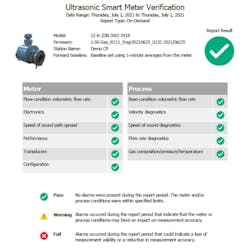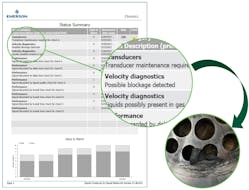History tells us that the Apollo Guidance Computer that carried the Apollo 11 mission to the moon had 32 KB of RAM, 72 KB of hard drive ROM and a processor running at 43 kHz. Using that as a benchmark, it is remarkable to consider the achievements of today’s technologies.
We could make similar comparisons to instrumentation transmitters, with early devices providing only the most rudimentary signal processing to linearize sensors and provide temperature compensation. Technology has advanced enormously with the processing and software capabilities contained in instrument transmitters, for example with 128MB of RAM in a typical Emerson ultrasonic flow meter (USM).
In this article, we will look at ways these improvements are used in one of the most challenging flow measurement applications: custody transfer of natural gas. This service calls for exceptionally high accuracy, across variable flow rates and pressures, with a wide range of pipe sizes. One technology for this application is growing rapidly due to its unique capabilities, namely the aforementioned USMs (Figure 1).
Constraints of traditional approaches
Custody transfer of natural gas presents a variety of challenges for any flow meter:
- Measurement must have high accuracy and repeatability, +/- 0.1% and 0.05% respectively.
- Wide range of pipe sizes from 3 inches to 24 inches.
- Pressure and flow rate variability depending on the source, demanding wide rangeability.
- Contaminants, including solid debris, are common.
- Piping configuration is not always ideal, with valves and elbows introducing flow disturbances.
These factors make consistent, precise measurements very difficult. The traditional approach of using a differential pressure (DP) flow measurement makes custody transfer problematic, particularly where turbulence is a problem and space constraints do not allow sufficient straight piping runs. Inconsistent results often force operators to inspect and recalibrate frequently, as often as every 30 days.
One of the underlying problems perpetuating this difficult situation is not always visible. The DP transmitter used in this application may be very accurate in itself, and it may have some useful self-diagnostic capabilities, but these may not provide insight into the flow measurement. If values are suspect, there is little alternative to launching a time-consuming and costly process of inspection and recalibration. Fortunately, USMs offer a better alternative for custody transfer applications.
Ultrasonic flow meters
USM technology employs the characteristic effects of ultrasound projected through a moving fluid. A sound pulse is transmitted upstream and downstream across the pipe in a chord (Figure 2), from a pair of transducers that act as both transmitters and receivers. Each pulse travels through the moving fluid, and its transit time differential between upstream and downstream trajectory indicates fluid velocity. This has several key benefits:
- There is no pressure drop since there are no pipe restrictions inherent to the meter, and none are needed upstream.
- It is unaffected by size, so it works well for small and large pipes.
- Multi-path designs like Emerson’s, with sound passing through multiple cross sections of the pipe for measurement of more of the pipe, identify and minimize velocity and turbulence effects.
Diagnostics provide multiple benefits
USMs using the latest designs have extensive built-in internal diagnostic capabilities, capable of diagnosing not only internal parameters, but also inferring much about the process. These diagnostics go far beyond anything that traditional technologies can see or report, so Emerson has created solutions specifically for this purpose, namely Smart Meter Verification device and process diagnostics (Figure 3), and MeterLink software.
Smart Meter Verification is a diagnostic tool for Emerson Coriolis, magnetic and ultrasonic flow meters, and for some Emerson level instruments. For this application, the ultrasonic flow transmitter uses on-board diagnostics to continuously monitor key performance indicators, including transducer health, to maintain measurement accuracy and meter integrity. This diagnostic tool can also be run on-demand to quickly verify performance issues, in less than 90 seconds, without interrupting flow or flow measurement. It provides early detection of potential issues, helping avoid escalation that could impact the product’s flow measurement performance.
To organize data from USMs, Emerson created MeterLink as a free software platform to serve all its ultrasonic offerings. As the range of diagnostic capabilities grows, the software is updated to keep pace, with new features and functionality added annually.
With these two offerings working together, it is easy to create reports of flow meter performance (Figure 4), including all elements capable of affecting accuracy. This automated analysis indicates whether the meter performance is within the measurement guidelines for AGA (American Gas Association) Report No. 9, Measurement of Gas by Multipath Ultrasonic Meters, when used in custody transfer applications.
MeterLink collects and summarizes enormous amounts of data, and it presents pertinent information in useful report formats, making it easy to understand and use. It highlights critical variables with color-coded green-OK, yellow-warning and red-failure indicators to draw operators’ attention quickly and convey status at a glance. Where multiple flow meters are in use, multiple instances of MeterLink can create reports covering all those in operation.
Detecting problems
Fluid turbulence, changing flow dynamics and dirt and debris are bad for flow meters of all kinds. USMs can tolerate these conditions better than many other types of flow meters, but to ensure accuracy, many custody transfer applications use perforated flow-straightening plates, called flow conditioners, to stabilize flow after process media passes through valves and elbows.
We tend to think of natural gas as a clean product, but all sorts of interesting debris can find its way into pipelines — particularly when they are operated at high pressure — and be carried by the gas until it encounters one of these conditioners at a custody transfer point. So how is a flow meter capable of detecting that a chunk of rubber, for example, has lodged at a flow conditioner upstream?
Using MeterLink, operators can monitor many variables, such as flow velocity patterns like asymmetry, and even turbulence at each of the measuring chords. With an eight-path meter (Figure 2), that means measuring at four points across the pipe using eight chords across the pipe’s cross section in two opposing directions for cancellation of flow effects. When the path velocity ratios change significantly from the normal flow profile and turbulence is high on one or more of the chords, it suggests some localized cause is responsible, such as upstream impediment, which could potentially affect overall accuracy of the measurement (Figure 5).
MeterLink will display these conditions and Smart Meter Verification will report when this type of change, or others, has been detected. If any change is over a specified threshold, the meter will create an alarm and log when the event occurred so operators can determine how and when to respond.
Improving flow operation
Any flow meter in custody transfer service should be regularly verified for performance and maintenance needs, but recalibration is not usually required. To ensure proper operation, constant monitoring is required, so in many respects, the monitoring side of flow measurement is as important as the measurement itself.
No matter how precisely a flow meter is calibrated in the factory, conditions in its actual installation will affect accuracy. Disruptions in the process, equipment updates and other changes should be closely monitored as they can have a significant impact on measurement and the bottom line. Blockages and adverse process conditions can easily go undetected without local operator or remote digital checks. If there are performance anomalies, they must first be identified before they can be investigated and solved.
However, on-site technicians may not be looking at alerts on a daily basis, so connecting to these and other data via remotely via diagnostics is the key to running a more efficient operation and ensuring that these critical measurement points remain accurate, as these platforms make identifying these abnormalities easier and faster.
Emerson USMs have been equipped with Ethernet since 2003, providing a high-speed digital communication link to control rooms. Operators can use these platforms to access overall status of one or more USMs via MeterLink or Smart Meter Verification reports, and custom charts and reports be created as needed.
USMs also have hundreds of data registers that can be accessed via a Modbus TCP/IP or Modbus RTU digital data link, and this diagnostic data includes Smart Meter Verification results on a daily and hourly basis. NetMonitor, a software module that comes with MeterLink, allows operators to view all the meters connected to a digital data network at once, providing an overview of any abnormalities.
NetMonitor shows the current status in real-time and allows quick access to any meter from the application’s group tray (Figure 6). This makes identifying a problem much more efficient, and it can eliminate unnecessary trips to the field and help optimize maintenance activities. The ability to view groups of meters at once expands the operator’s view of the overall process, providing them with the information needed to quickly confirm a process issue when multiple meters at a site or station report the same anomalous behavior.
If a meter issue has been identified, the Smart Meter Verification reports provide explanations and troubleshooting instructions, and the meter’s manual also provides illustrated instructions for any required maintenance. With Rosemount USMs, most maintenance issues do not disrupt operation. For example, transducers can be removed and replaced while the pipeline is pressured, and replacing a pair of transducers or updating the electronics typically does not require recalibration.
Meter diagnostics are baselined at initial calibration, and sometimes also when they are first installed in the field. Trending this meter diagnostic fingerprint over time provides a good indication of whether the meter is drifting from its original calibration.
Smart Meter Verification can trend hourly data, and the meter itself keeps detailed diagnostic records, with an audit trail going back as far as five years. This data is available through secured local area networks, and through gateways or edge devices onsite, with some information available through polling the aforementioned registers via Modbus.
These and other requirements place two main demands on operating companies: first, the flow meter accuracy must be beyond question; and second, the more the measurement can be verified the more confident the operators can be. Today’s ultrasonic flow meters, with their sophisticated diagnostic capabilities working in conjunction with support platforms such as Smart Meter Verification and MeterLink, can meet these requirements on a real-time, hourly, daily and/or monthly basis.
Lonna Dickenson is the product director for the Emerson gas and liquid Rosemount ultrasonic flow meters. She is the global product leader for ultrasonic technology at Emerson, where she has led vision, strategy and product development for the fiscal gas ultrasonic portfolio over the past 11 years in Emerson’s Flow Technology Group. Dickenson holds a Bachelor of Science from the University of Texas at Austin, and an MBA from Rice University in Houston.
Emerson







